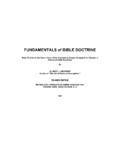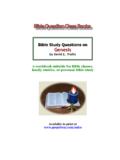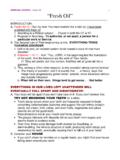Transcription of Definition of a False Religion - Biblefacts.org
1 Cults - Ancient and Modern 60 Definition of a False Religion Jesus teaches things about Himself and commands us to believe Him and follow His ways. There are other religions that will truthfully admit they are not Christian and do not follow the teachings of Jesus. Since prophecy proves the bible is true, it follows then that all those groups are False religions, and those who hold to them will die and spend eternity in hell. These four great non-Christian False religions include: Hinduism Buddhism Paganism Islam Each False Religion will have subgroups or denominations that are considered orthodox to that Religion . But each False Religion will also have cults. These cults claim to be the true Religion but deny some major doctrine of that Adam Noah Pre-Flood Paganism Judaism Christianity Islam Hinduism Buddhism Jainism Sikhism Druidism Wicca Post-Flood Paganism Shamanism Confucianism Taoism Shinto Definition of a False Religion 61 Religion s holy book (the bible , Qur an, Vedas, Pali texts, etc.)
2 For example, the Nation of Islam claims to be the real Islam, but it is considered an Islamic cult by all Muslims. Sikhism mixes Hinduism and Islam together and is therefore considered a cult by both of these False religions. Rasta claims to be the real Judaism, but it is considered a Jewish cult. Jehovah s Witnesses claim to be the real Christianity, but are considered a Christian cult because they deny Jesus own teaching that He is divine. Cults - Ancient and Modern 62 Hinduism The holy books of Hinduism are called the Vedas and the Upanishads. The basic tenets of Hinduism are: Evolution: Life on planet earth is constantly changing into new and higher forms of life. Reincarnation: the belief that when a person dies he will then be reborn into the body of another human or lower form of life. Karma: the belief that if a person was evil in this life he might be reborn into a lower form of life, and if he was good, he could be born into a higher form of life.
3 This is also called transmigration of souls or the caste system. Pantheism: the belief that god is a force that is in everything (people, animals, plants, rocks etc.) This is the opposite of the Christian God, who is personal and completely separate from His creation. Because of the belief in pantheism, the Hindu Religion has thousands of gods and goddesses. Each is supposed to represent a different part of god. Brahman: the impersonal god. Emanation: The doctrine that part of what the original god was/is, is in each and every human being. Atman: the essence of that impersonal god, that is in each human being. Hinduism According to the ancient post-flood history of the Jews, Noah s descendants knew and worshiped the one true God. An evil king, Nimrod, was the first to rebel against God and bring back the corrupt pre-flood Religion . After Nimrod s death, about 1800 BC, some of his posterity, Hinduism 63 along with their corrupt religious ideas, were driven away from the Middle East to the Indus valley of India.
4 They became known as the Dravidians or the Vedic race. We have many of their writings; but, their language has never been deciphered. A century or two later, a Japhetic race came down and intermarried with the Hamatic Dravidians. They brought with them the Aryan language, Sanskrit. The oldest copy of the Rig Veda (a Hindu poem written in Sanskrit) is dated about 1450 BC. The difference between Nimrod s death at 1800 BC and 1450 BC is 325 years. So the development of the Hindu Religion , as we know it, happened in only 325 years. Even inside Hinduism there are memories of real history. Hinduism teaches that the earth has been destroyed many times. In the last destruction, a man named Satyavarata (also called Manu) built a ship and escaped a great flood, landing on Mt. Hivamet in northern India. (This is according to the Hindu poem Mahabarata.) When we look at the oldest parts of the Hindu holy books, the Vedas and the Upanishads, we see references to animal sacrifice to God.
5 There are no verifiable prophecies in any of the Hindu holy books. Hinduism teaches that humans are evolving into gods or will become part of the gods by escaping the cycle of reincarnation and enter into nirvana. The divine part of man is called the Atman. The Shastabad Voltaire, Benjamin Franklin, and other founding fathers believed Hinduism originally taught monotheism. An ancient Hindu manuscript called the Shastabad of Brahma Cults - Ancient and Modern 64 teaches that there was one God and He created angels and man. Regarded as gods today by Hindus, Brahma, Shiva, and Vishnu were originally three of these angels. The Shastabad tells of the fall of the angels and man and the worldwide destruction of the earth by a flood. This was proof enough for America s founding fathers to conclude that Hinduism has a memory of the real history of the earth as described in the bible and that Hinduism itself was a cultic break off of the true Religion now completely revealed by the Scriptures.
6 Cultic Break-offs of Hinduism Buddhism and Jainism are break offs of Hinduism and Hindus consider each a cult. The Self Realization Fellowship and the Hare Krishna s are examples of Hindu cults that mix Hinduism with Christianity. Sikhism is an example of a Hindu cult that mixes Hinduism with Islam. Jainism Jainism was founded in fifth century BC (the same time as Buddhism). While Buddhism is the middle way, Jainism is the strict way. Jainism and Buddhism are both offshoots of Hinduism. Jainists reject the Hindu gods but believe everything is an inferior god. The chief god is Mahavira. But he can t help you gain salvation (release from karma and reincarnation). They teach five tenets: destroy no life, do not lie, practice charity, practice chastity, posses nothing and want nothing. They have two denominations: the Diganbara, monks and nuns living in monasteries who make a vow of nudity; and Svatembara, monks and nuns who wear white robes.
7 Hinduism 65 Sikhism Sikhism was founded in the fifteenth century AD by Guru Nanak in an effort to unite Hindus and Muslims. Sikh means disciple. Two of the original ten gurus who started the Religion were murdered. Originally a pacifist Religion , after being persecuted by both Hindus and Muslims they became militant and took up arms. They are recognized by their heavy beards and long-coiled turbans which are a symbol of the unity of the brotherhood. From Hinduism Sikhs adopt the teachings of reincarnation, karma, and the Hindu festivals, but reject the caste system and Hindu gods. From Islam they adopt the concept that there is only one god, who is truth, creator, immortal, and omnipresent. They teach that this god has never incarnated into a human being. They also forbid images in their temples. They are vegetarians and abstain from alcohol and tobacco. They pray/meditate using the Nama, the constant repetition of the name of god.
8 They think that by doing good works a Sikh will obtain union with god, but if they disobey their holy book, the Granth Sahib, they will be doomed to an endless cycle of reincarnations, and denied a reunion with god. Sikh s have no concept of proving the truth of their beliefs by using verifiable prophecy. Cults - Ancient and Modern 66 Buddhism Buddhism is an outgrowth of Hinduism. Hinduism and Buddhism alike teach man is trapped in an endless cycle of reincarnation. The goal of the Buddhist is to escape this cycle and go back into Nirvana, which is defined as the nothingness from which he came. This is not the same thing as the Christian concept of heaven, where a person continues to exist. This is a total extinction of life. They teach no individual has a soul and yet each man is divine. They believe in pantheism (everything is god) and self-salvation. Gautama Buddha was a Hindu priest in India around 500 BC.
9 About 477 BC, after the death of Gautama, his disciples put together the Sutra's (Sayings of Buddha) and the Vinaya (rules and regulation of the Buddhist order). Together these form the Dharma (teachings of Buddha). In 245 BC, the third Buddhist council was held. This council formed the definitive canon called the Pali texts. These teachings deny the authority of the Hindu Vedas. This is why Hindus regard Buddhism a heretical cult that broke away from Hinduism. Today we have four distinct schools of Buddhism. Theravada Buddhism: This is the oldest school of Buddhism. They follow the Sutra and Vinaya very strictly. They consider Buddha a great ethical teacher. Only Buddhist monks are allowed to study the Sutra and Vinaya. Buddhists are encouraged to become Arhats (Buddhist saints who have achieved their own deliverance from the cycle of reincarnation). Nirvana is not limited to monks. Buddhism 67 Mahayana Buddhism: This school was formed about 400 AD.
10 They consider Buddha to be a god. Everyone is allowed to study the Pali texts. Nirvana is reserved only to those who follow the discipline of the Pali texts rigidly. Buddhists are encouraged to become Bodhisattvas (people who are destined for Buddha-hood, or godhood, but delay this for the purpose of teaching others.) Zen Buddhism: This school of Buddhism formed in Japan. It teaches that one reaches enlightenment through certain ways of meditation and thought. This cannot be defined or put into words but must be experienced. Tibetan Buddhism: This school formed about 700 AD. This is basically Buddhism mixed with Shamanism, magic, and nature worship. While in the other forms of Buddhism the monks are celibate, Tibetan Buddhist practice Tantra. Tantra teaches a method of obtaining enlightenment, or godhood, through sex. The dark side of Tantra is very perverted.







